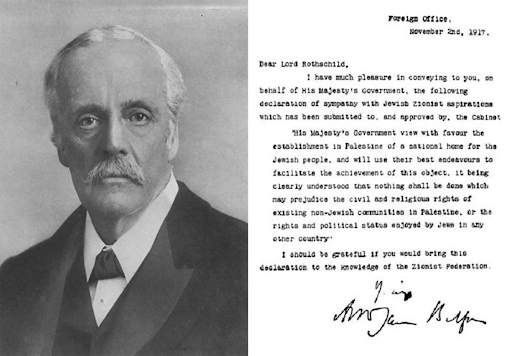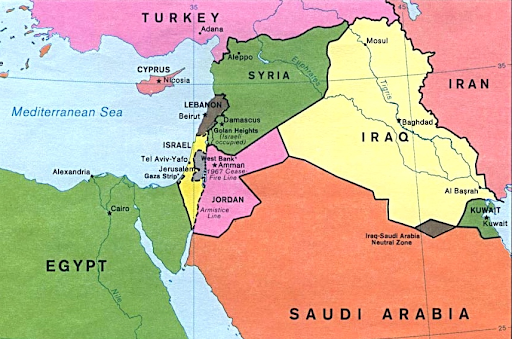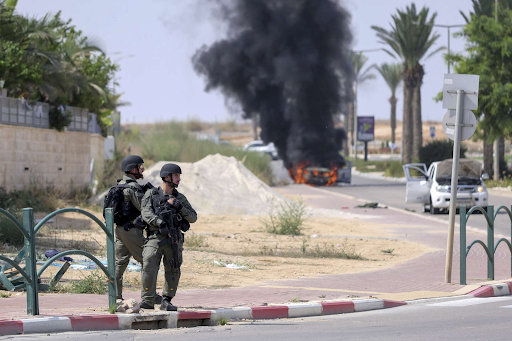
Hamas, the Palestinian militant group, started an unusual attack on Israel on October 7th due to the unwanted possession of their country. During the attack, hundreds of gunmen entered communities near the Gaza Strip. The clash resulted in at least 1,400 deaths among Israelis, and the Israeli military reported that 203 fighters and civilians, including women and children, were taken as prisoners in Gaza. In response, the Israeli military carried out air and artillery strikes in Gaza, resulting in the deaths of more than 3,700 Palestinians. Israeli troops have also gathered along the Gaza border, raising concerns about a potential large-scale ground operation. Meanwhile, Israel set a complete block up on Gaza, leading to a lack of essential supplies, including food and fuel.
Israel’s History and the Balfour Declaration
After the collapse of the Ottoman Empire during World War I, Britain took control of the region known as Palestine. This region was occupied by a Jewish minority, a larger Arab majority, and many smaller ethnic groups.
Tensions between these two major population groups intensified when the international community assigned the UK to set a “national home” in Palestine for Jewish people. This command originated from the Balfour Declaration of 1917, an affirmation made by then Foreign Secretary Arthur Balfour to Britain’s Jewish community.
The Balfour Declaration was officially incorporated into the British ruling over Palestine and received approval from the newly established League of Nations, a precursor to the United Nations, in 1922. While Jewish people considered Palestine as their inherited homeland, Palestinian Arabs also laid claim to the territory and opposed this development.

From the 1920s through the 1940s, there was a significant increase in the entry of Jewish immigrants to the region. Many were escaping persecution in Europe, particularly in the wake of the Nazi Holocaust during World War Two.
During this time, there was a rise in violence, involving conflicts between Jewish and Arab communities and resilience against British rule.
In 1947, the United Nations passed a resolution supporting the division of Palestine into separate Jewish and Arab states, establishing Jerusalem as an international city. While Jewish authorities accepted this plan, it met rejection from the Arab side and was never put into impact.
The Creation of Israel
In 1948, with an unsolved conflict, Britain pulled out its order, and Jewish leaders declared the establishment of the State of Israel. The immediate purpose was to provide a refuge for Jews escaping persecution and to establish a national homeland for them.
During the initial months, tensions between Jewish and Arab militias had been increasing. Just a day after Israel announced its statehood, five Arab nations conducted an attack. This incident marked the commencement of a war that led to the exit of hundreds of thousands of Palestinians from their homes, an event they refer to as “Al Nakba,” or the “Catastrophe.”
When the clash ended with a ceasefire the next year, Israel gained power over the majority of the territory. Jordan occupied the area that became known as the West Bank, while Egypt took control of Gaza. Jerusalem was separated, with Israeli forces in the West and Jordanian forces in the East.
The region has seen more wars and ongoing militancy in the next decades because a lasting peace agreement was never reached.
An Illustrated Map of Israel
During the 1967 war, Israel seized possession of East Jerusalem, the West Bank, the majority of the Syrian Golan Heights, Gaza, and the Egyptian Sinai peninsula. The onset of this conflict led to a significant Palestinian refugee community and their descendants inhabiting areas like Gaza, the West Bank, Jordan, Syria, and Lebanon.
Yet, Israel has constantly refused to allow them or their descendants to return to their original homes. The motive behind this Israeli perspective is the concern that such a retrieval would pose a staggering challenge to the country and possibly compromise its identity as a Jewish state.

Momentarily, Israel keeps its occupation of the West Bank, maintaining a claim to the aggregate of Jerusalem as its capital. Contrarily, the Palestinians claim East Jerusalem as the capital of their expected future state. It’s worth noting that the United States is one of only a few nations identifying Jerusalem as Israel’s capital.
Over the past five decades, Israel has established settlements in both the West Bank and East Jerusalem, which are now home to over 700,000 Jewish nationals. It’s important to note that these settlements are considered illegal under international law, a perspective held by entities such as the UN Security Council and the UK government, although Israel denies this depiction.
The Gaza Strip
The Gaza Strip is a limited piece of land situated between Israel and the Mediterranean Sea, with a little border to the south shared with Egypt. Estimating just 41 kilometers (25 miles) in length and 10 kilometers in width, it is home to over two million residents and stands out as one of the world’s most densely populated regions.
After the 1948-49 war, Gaza was under Egyptian possession for 19 years. In the 1967 war, Israel took control of Gaza and stayed there until 2005. During its occupation, Israel set up Jewish settlements in the area.
Israel removed its troops and settlers from Gaza in 2005, though it maintained authority over the territory’s airspace, shared border, and coastline. The United Nations continues to categorize Gaza as being under Israeli occupation.
What Are the Key Unresolved Issues Between Israelis and Palestinians?
Multiple controversial issues have restricted agreement between the two sides, including:
- The future of Palestinian emigrants.
- The status of Jewish territories in the occupied West Bank – should they remain or be disassembled?
- The question of dividing Jerusalem between Israelis and Palestinians.
- The demanding prospect of establishing a Palestinian state beside Israel.

Previous Peace Plans
Peace negotiations between Israel and the Palestinians rarely from the 1990s through the 2010s, separated by occasional outbreaks of roughness. There was a ray of hope in the early days, with private talks in Norway leading to the Oslo peace process. This strategy terminated in a historic moment when the Palestinians identified the State of Israel, and Israel recognized the Palestine Liberation Organization (PLO) as the only representative of the Palestinian people. As a result, a self-governing Palestinian Authority was established.
However, problems emerged soon. Opposition leader Benjamin Netanyahu criticized the Oslo Accord, calling it a danger to Israel’s safety. Israel also spread its settlement activities in the occupied Palestinian territories during this time. Further, the rise of the Palestinian militant group Hamas complicated the peace process.
The condition in Israel became increasingly tense, leading to the tragic murder of Israeli Prime Minister Yitzhak Rabin by a Jewish extremist on November 4, 1995.
Actions to revive the peace process were made in the 2000s, including the introduction of a roadmap in 2003, backed by world powers with the goal of a two-state solution. However, this roadmap was never fully implemented.
Peace efforts faced a significant setback in 2014 when talks between Israelis and Palestinians in Washington failed to deliver results.
The most recent peace plan, known as “the deal of the century,” was presented by the U.S. during Donald Trump’s presidency. Prime Minister Netanyahu commanded it, but the Palestinians considered it as one-sided and the plan never materialized.
Root Causes of the Ongoing Conflict Between Israel and Gaza
Gaza is under the power of Hamas, an Islamist group that is openly dedicated to the destruction of Israel. It’s essential to note that many countries, including the UK, have assigned Hamas as a terrorist organization.
Hamas appeared victorious in the Palestinian elections of 2006 and later took control of Gaza in 2007 by replacing the Fatah movement, led by West Bank-based President Mahmoud Abbas.
Since then, Gaza has evident various armed conflicts with Israel. Israel, along with Egypt, has enforced a partial blockade on Gaza to separate Hamas and prevent attacks, particularly the firing of rockets toward Israeli cities.

Palestinians in Gaza argue that Israel’s obstructions and airstrikes, especially in highly populated areas, amount to communal punishment. This year has observed a rise in fatal incidents in the occupied West Bank and East Jerusalem. Palestinians also raise concerns about restrictions and military actions in response to attacks on Israelis.
The recent rise of tensions could be one of the factors behind Hamas’s latest attack. Further, militants may seek to increase their popularity among ordinary Palestinians and pressurize Israel to release some of the almost 4,500 Palestinians kept in Israeli prisons.
Allies and Opponents
The United States, along with the European Union and various Western countries, has vigorously criticized the recent attack by Hamas on Israel. The U.S., as Israel’s devoted ally, has provided great military and economic aid, totaling over $260 billion. Similarly, the U.S. has committed additional military supplies, air defense missiles, guided shells, and ammunition.
In reaction to the conflict, the United States has utilized two aircraft carrier strike groups to the eastern Mediterranean, planning to deter possible actions by Israel’s rivals, including Lebanon’s Hezbollah.
Contrarily, Russia and China have not blamed Hamas. They have expressed their intent to maintain communication with both sides concerned in the conflict. Russian President Vladimir Putin has pointed to U.S. policies as the cause of the absence of peace in the Middle East.
Iran, a long-standing opponent of Israel, delivers significant aid to Hamas, as well as to Hezbollah. These two groups have been involved in near-daily encounters with Israeli forces since the onset of the conflict.
Concerning Iran’s role in the Hamas attack, queries have arisen due to reports indicating that Iran may have approved the attack in the days leading up to it. However, Tehran has disowned any engagement in the affair.





